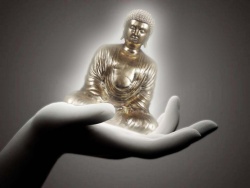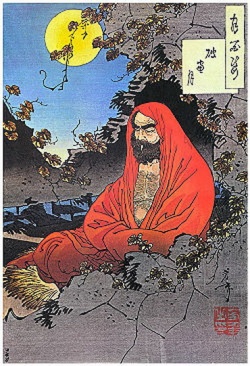Meanings of Colors in Tibetan Buddhism
All of the colors used in Tibetan art and its rituals holds specific meanings. There are five main colors that are known as pancha-varna in Sanskrit, which means The Five Pure Lights. Each color represents a state of mind, a celestial Buddha, a body part, a part of the mantra word Hum or a natural element. It is believed that by meditating on the individual colors, which contain their respective essences and are associated with a particular buddha or bodhisattva, spiritual transformations can be achieved.
Blue is associated space are represents purity and healing. Akshobhya is the Buddha of this color. Ears are the body part that is represented by the color blue. Air is the element that accompanies this color. It is believed, when meditating on this color, anger can be transformed into wisdom.
White is associated with air and is the color of learning and knowledge in Buddhism. It is represented by the Buddha Vairocana. The eyes are associated with white. White is in the elemental group water. If meditated upon, white can cut the delusion of ignorance and turn it into the wisdom of reality.
Red is associated with fire and is related to life force and preservation. The Buddha Amitabha is depicted with a red body in Tibetan art. The part of the body associated with this color is the tongue. Fire is the natural element complementary to the color red. In Buddhism, meditating on the color red transforms the delusion of attachment into the wisdom of discernment.
Green is associated with water and is the color of balance and harmony. Amoghasiddhi is the Buddha of the color green. The head is the body part that is associated with this color. Green represents nature. Meditate on this color to transform jealousy into the wisdom of accomplishment.
Yellow is associated with with earth and symbolizes rootedness and renunciation. Buddha Ratnasambhava is associated with yellow. The nose is represented by this color. Earth is the element that accompanies the color yellow. Yellow transforms pride into wisdom of sameness when visualized in meditation.
The Five Pure Lights are often seen in Mandala and Tibetan Buddhist prayer flags which you can see everywhere if you make a tour to Tibet. The colors may vary, but there is always a set of five. In addition to this, there is the Buddhist concept of the "rainbow body. The rainbow body is a concept in Tibetan Buddhism when everything begins to transform into pure light. It is said to be the highest state attainable in the realm of samsara before the "clear light" of Nirvana. As the spectrum contains within itself all possible manifestations of light, and thus of color, the rainbow body signifies the awakening of the inner self to the complete reservoir of terrestrial knowledge that it is possible to access before stepping over the threshold to the state of Nirvana. Understandably, when depicted in the visual arts, due to the profusion of colors, the result is spectacularly unique.

